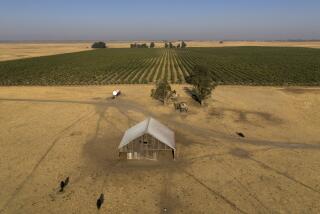Project Study Goes to Board
- Share via
Overwhelmed by a third day of testimony and a hill of documents on the controversial Ahmanson Ranch subdivision, Ventura County supervisors decided Wednesday to sleep on the project and begin their deliberations this morning.
Supervisors are being asked by the developer, Washington Mutual Bank, to approve a new environmental study of the 3,050-home project overlooking the San Fernando Valley.
Washington Mutual could then seek permits from state and federal agencies to break ground.
Opponents want the supervisors to require more study before they give the project the green light. The recent discovery of the chemical perchlorate in a well for watering the project’s golf courses has alarmed critics, several state lawmakers and water regulators.
Although perchlorate, which can cause thyroid cancer, received little attention in the study supervisors are now evaluating, it became the focus of 16 hours of public hearings that concluded Wednesday. With every speaker, the stacks of reports, studies, maps and other documents seemed to grow on the supervisors’ dais.
“I’m buried in paper here,” Supervisor Kathy Long said, searching for a particular document.
As both sides wrapped up testimony, Supervisor Judy Mikels asked repeat speakers to identify themselves again.
“I’m losing track of people’s connections, and I’m trying to keep it straight in my mind,” she said.
Board Chairman John Flynn said he decided to begin deliberations today, rather than Wednesday afternoon, so he and his colleagues can review all the material.
“I want to go through the expert-written testimony,” he said. “I just want to have a better understanding of perchlorate. And I’m getting that now.”
Perchlorate is used in the manufacture of rocket fuel, some fertilizers, fireworks and vehicle air bags. It can cause a host of health problems in humans and animals, even in small amounts.
Washington Mutual has said it will use another source of water for irrigation if the contaminated well cannot be made safe.
The developer’s lead attorney, Steve Weston, implored supervisors to hold the Ahmanson Ranch project to the same standards as other developments and not be distracted by what he said were opponents’ dogged efforts to stir up controversy and stall.
“Be fair,” he said.
The state’s process for assessing the environmental impact of building projects “is not intended to be an endless process that drags on and on and on,” Weston said.
The $2-billion project was initially approved in 1992, but developers ordered the new study after endangered frogs and flowers were found on the property in 1999.
Those who want to see Ahmanson Ranch devoted to parkland, not homes, question why the developer opposes further study.
“If they weren’t afraid of what they’d find, they would simply agree to further soil and water testing,” said Chad Griffin, spokesman for Rally to Save Ahmanson Ranch.
However, opponents have another reason for delaying a vote. In January they expect to gain an ally on the divided Board of Supervisors: Supervisor-elect Linda Parks, who replaces Ahmanson Ranch proponent Frank Schillo. Supervisors could delay voting until after Parks joins the board.
More to Read
Sign up for Essential California
The most important California stories and recommendations in your inbox every morning.
You may occasionally receive promotional content from the Los Angeles Times.













